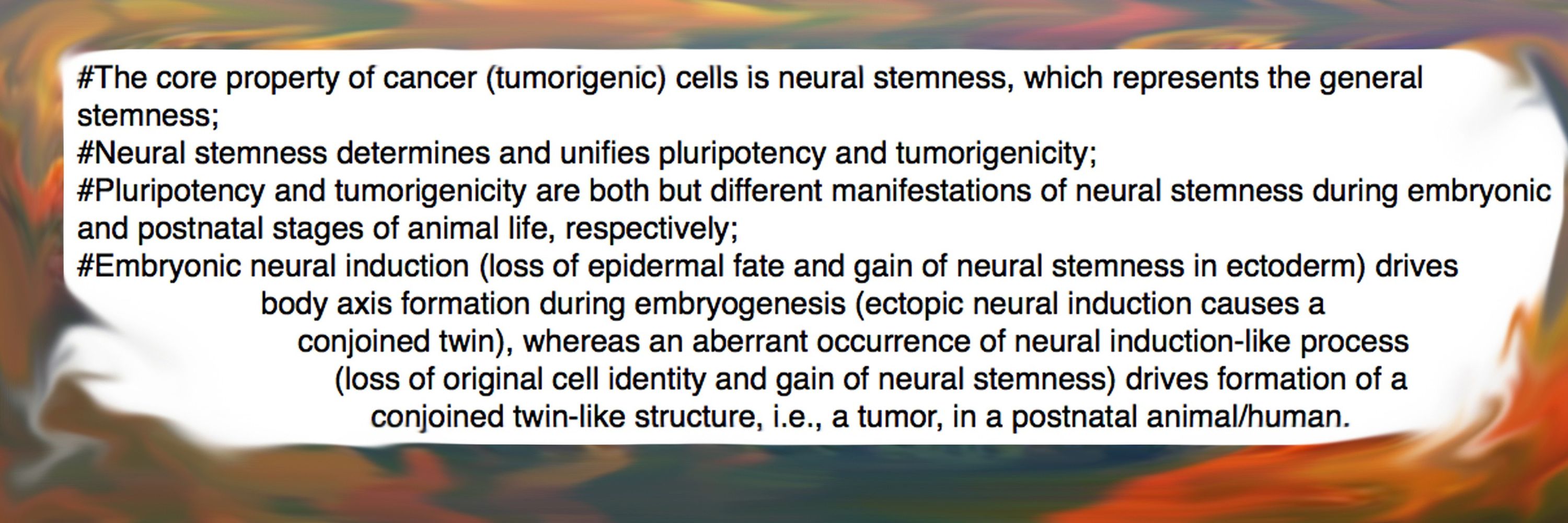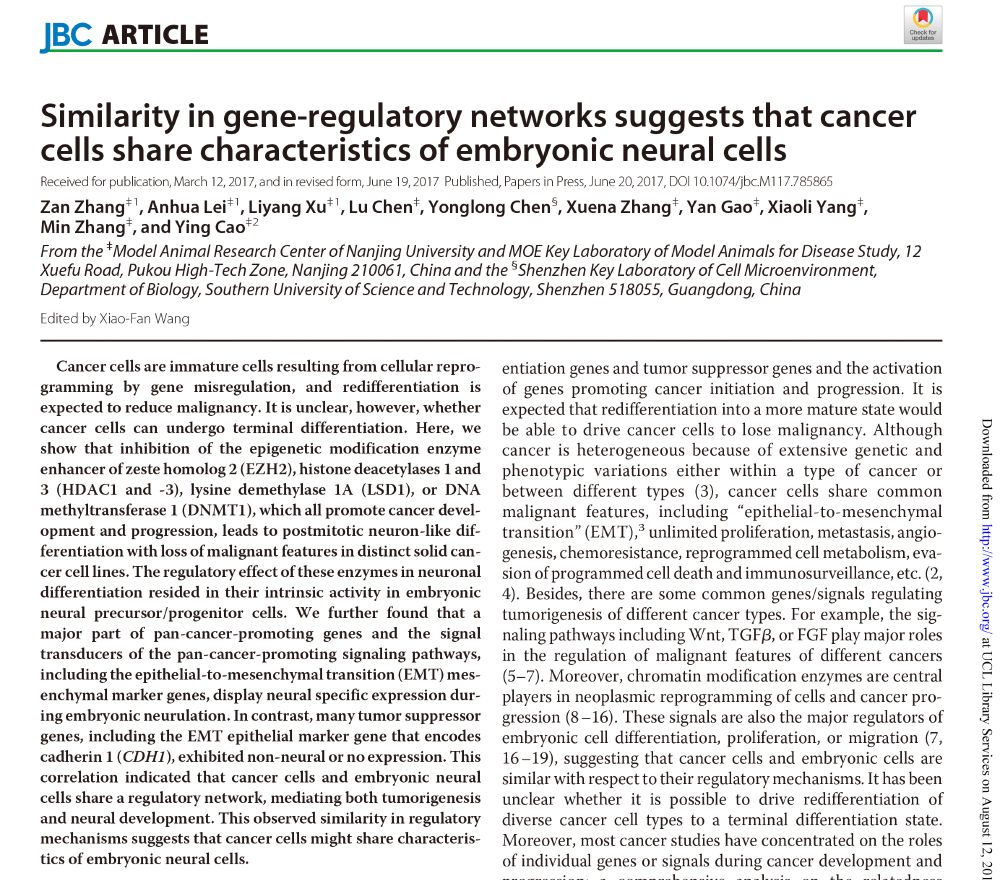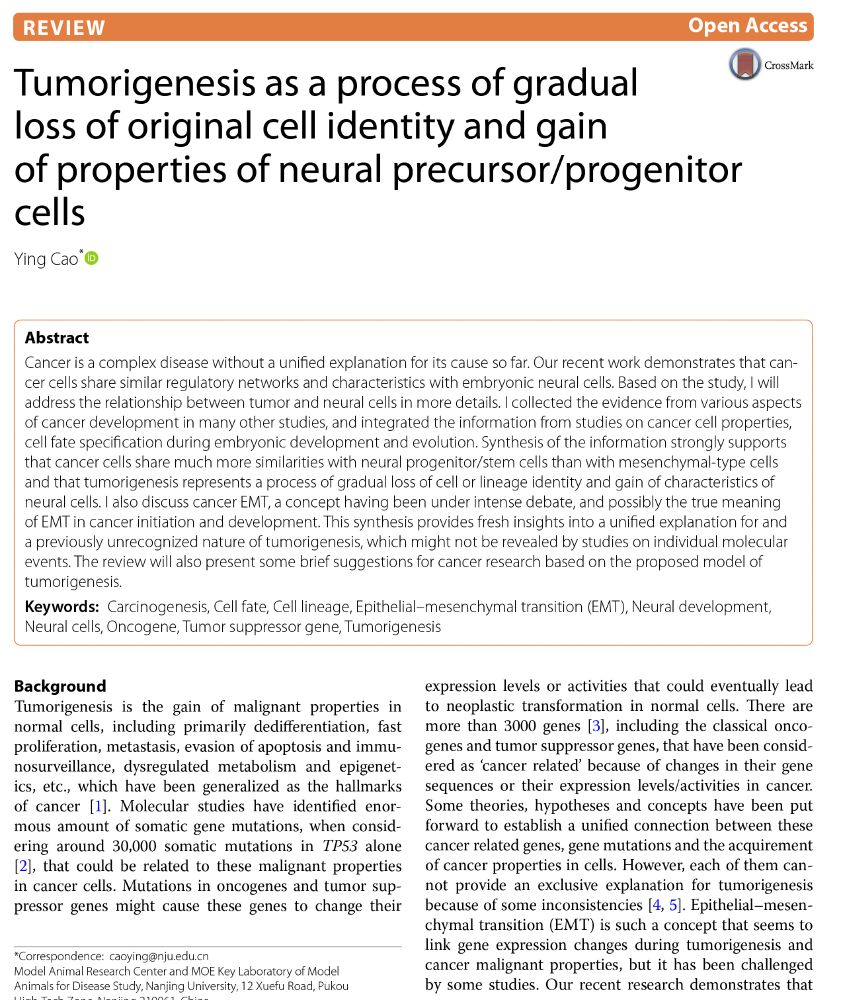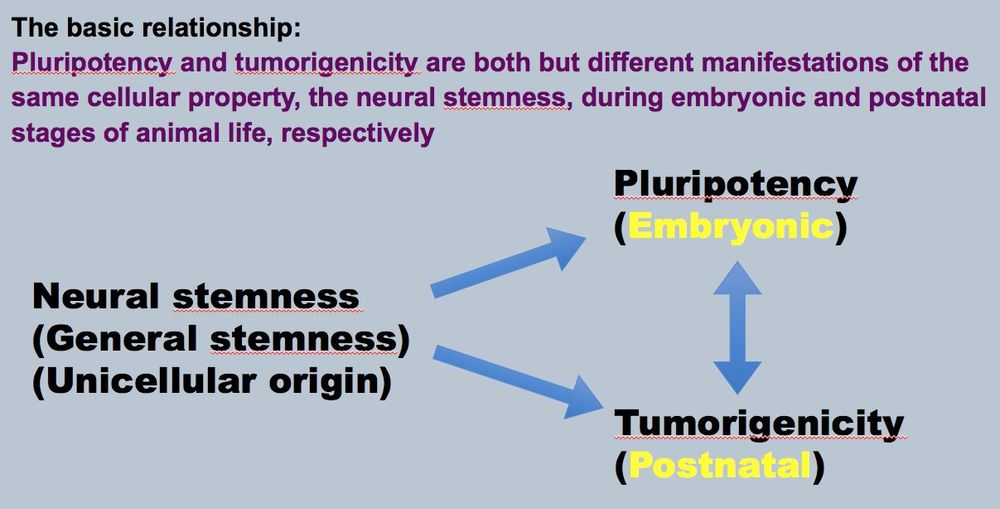
Ying Cao
@neuralgrndstate.bsky.social
Cancer is a systemic disease. Understanding a systemic disease needs systemic rules: Tumorigenesis is a process of progressive loss of original cell identity and gain of neural stemness, the general stemness that determines tumorigenicity and pluripotency.
‘Understanding Cancer as a Systemic Disease by Understanding Neural Stemness as the Core Property of Cancer Cell’
preprints.org/manuscript/2...
preprints.org/manuscript/2...




November 7, 2025 at 7:24 AM
‘Understanding Cancer as a Systemic Disease by Understanding Neural Stemness as the Core Property of Cancer Cell’
preprints.org/manuscript/2...
preprints.org/manuscript/2...
For knowing what is embryonic (neural) induction, refer to the experiment done by Spemann and Mangold in 1924 and subsequent studies.
October 29, 2025 at 6:06 AM
For knowing what is embryonic (neural) induction, refer to the experiment done by Spemann and Mangold in 1924 and subsequent studies.
'Understanding Cancer as a Systemic Disease by Understanding Neural Stemness as the Core Property of Cancer Cell'
www.preprints.org/manuscript/2...
www.preprints.org/manuscript/2...


October 28, 2025 at 11:59 AM
'Understanding Cancer as a Systemic Disease by Understanding Neural Stemness as the Core Property of Cancer Cell'
www.preprints.org/manuscript/2...
www.preprints.org/manuscript/2...
Which were planned to present at a meeting but failed😂
October 27, 2025 at 12:10 PM
Which were planned to present at a meeting but failed😂
Basic rules in cancer.
'Understanding Cancer as a Systemic Disease by Understanding Neural Stemness as the Core Property of Cancer Cell'
www.preprints.org/manuscript/2...
'Understanding Cancer as a Systemic Disease by Understanding Neural Stemness as the Core Property of Cancer Cell'
www.preprints.org/manuscript/2...




October 17, 2025 at 12:24 PM
Basic rules in cancer.
'Understanding Cancer as a Systemic Disease by Understanding Neural Stemness as the Core Property of Cancer Cell'
www.preprints.org/manuscript/2...
'Understanding Cancer as a Systemic Disease by Understanding Neural Stemness as the Core Property of Cancer Cell'
www.preprints.org/manuscript/2...
Understanding cancer is a life-saving business.😂

October 8, 2025 at 7:39 AM
Understanding cancer is a life-saving business.😂
The points regarding EMT (or related stuffs) that need to be clarified. Please repost.

October 8, 2025 at 7:38 AM
The points regarding EMT (or related stuffs) that need to be clarified. Please repost.
'Lack of basic rationale in epithelial-mesenchymal transition and its related concepts'
cellandbioscience.biomedcentral.com/articles/10....
'Understanding Cancer as a Systemic Disease by Understanding Neural Stemness as the Core Property of Cancer Cell'
www.preprints.org/manuscript/2...
cellandbioscience.biomedcentral.com/articles/10....
'Understanding Cancer as a Systemic Disease by Understanding Neural Stemness as the Core Property of Cancer Cell'
www.preprints.org/manuscript/2...

Lack of basic rationale in epithelial-mesenchymal transition and its related concepts - Cell & Bioscience
Epithelial–mesenchymal transition (EMT) is defined as a cellular process during which epithelial cells acquire mesenchymal phenotypes and behavior following the downregulation of epithelial features. EMT and its reversed process, the mesenchymal-epithelial transition (MET), and the special form of EMT, the endothelial-mesenchymal transition (EndMT), have been considered as mainstream concepts and general rules driving developmental and pathological processes, particularly cancer. However, discrepancies and disputes over EMT and EMT research have also grown over time. EMT is defined as transition between two cellular states, but it is unanimously agreed by EMT researchers that (1) neither the epithelial and mesenchymal states nor their regulatory networks have been clearly defined, (2) no EMT markers or factors can represent universally epithelial and mesenchymal states, and thus (3) EMT cannot be assessed on the basis of one or a few EMT markers. In contrast to definition and proposed roles of EMT, loss of epithelial feature does not cause mesenchymal phenotype, and EMT does not contribute to embryonic mesenchyme and neural crest formation, the key developmental events from which the EMT concept was derived. EMT and MET, represented by change in cell shapes or adhesiveness, or symbolized by EMT factors, are biased interpretation of the overall change in cellular property and regulatory networks during development and cancer progression. Moreover, EMT and MET are consequences rather than driving factors of developmental and pathological processes. The true meaning of EMT in some developmental and pathological processes, such as fibrosis, needs re-evaluation. EMT is believed to endow malignant features, such as migration, stemness, etc., to cancer cells. However, the core property of cancer (tumorigenic) cells is neural stemness, and the core EMT factors are components of the regulatory networks of neural stemness. Thus, EMT in cancer progression is misattribution of the roles of neural stemness to the unknown mesenchymal state. Similarly, neural crest EMT is misattribution of intrinsic property of neural crest cells to the unknown mesenchymal state. Lack of basic rationale in EMT and related concepts urges re-evaluation of their significance as general rules for understanding developmental and pathological processes, and re-evaluation of their significance in scientific research.
cellandbioscience.biomedcentral.com
October 8, 2025 at 7:36 AM
'Lack of basic rationale in epithelial-mesenchymal transition and its related concepts'
cellandbioscience.biomedcentral.com/articles/10....
'Understanding Cancer as a Systemic Disease by Understanding Neural Stemness as the Core Property of Cancer Cell'
www.preprints.org/manuscript/2...
cellandbioscience.biomedcentral.com/articles/10....
'Understanding Cancer as a Systemic Disease by Understanding Neural Stemness as the Core Property of Cancer Cell'
www.preprints.org/manuscript/2...
It is not the indefinable EMT but neural stemness that unifies cancer cell phenotypic traits.
See the intrinsic relevance between neural stemness and cancer cell. Is there any relation between cancer cell and the indefinable mesenchymal state, just a few misinterpreted molecules?
See the intrinsic relevance between neural stemness and cancer cell. Is there any relation between cancer cell and the indefinable mesenchymal state, just a few misinterpreted molecules?

October 8, 2025 at 7:35 AM
It is not the indefinable EMT but neural stemness that unifies cancer cell phenotypic traits.
See the intrinsic relevance between neural stemness and cancer cell. Is there any relation between cancer cell and the indefinable mesenchymal state, just a few misinterpreted molecules?
See the intrinsic relevance between neural stemness and cancer cell. Is there any relation between cancer cell and the indefinable mesenchymal state, just a few misinterpreted molecules?
Nobody knows what is EMT, but it is believed that it explains cancer metastasis.
Neural stem/progenitor cells are well known for their single cell migration&cancer cells are characteristic of neural stemness, but people avoid mentioning it&seek helps from some indefinable stuffs for understanding.
Neural stem/progenitor cells are well known for their single cell migration&cancer cells are characteristic of neural stemness, but people avoid mentioning it&seek helps from some indefinable stuffs for understanding.



October 8, 2025 at 7:34 AM
Nobody knows what is EMT, but it is believed that it explains cancer metastasis.
Neural stem/progenitor cells are well known for their single cell migration&cancer cells are characteristic of neural stemness, but people avoid mentioning it&seek helps from some indefinable stuffs for understanding.
Neural stem/progenitor cells are well known for their single cell migration&cancer cells are characteristic of neural stemness, but people avoid mentioning it&seek helps from some indefinable stuffs for understanding.
'EMT' and cancer:
It is not the mesenchymal but neural stuff that is truly critical for understanding cancer.
'Understanding Cancer as a Systemic Disease by Understanding Neural Stemness as the Core Property of Cancer Cell'
preprints.org/manuscript/2...
It is not the mesenchymal but neural stuff that is truly critical for understanding cancer.
'Understanding Cancer as a Systemic Disease by Understanding Neural Stemness as the Core Property of Cancer Cell'
preprints.org/manuscript/2...


October 8, 2025 at 7:32 AM
'EMT' and cancer:
It is not the mesenchymal but neural stuff that is truly critical for understanding cancer.
'Understanding Cancer as a Systemic Disease by Understanding Neural Stemness as the Core Property of Cancer Cell'
preprints.org/manuscript/2...
It is not the mesenchymal but neural stuff that is truly critical for understanding cancer.
'Understanding Cancer as a Systemic Disease by Understanding Neural Stemness as the Core Property of Cancer Cell'
preprints.org/manuscript/2...
Why the intrinsic feature of single-cell migration of neural crest cells must be explained with EMT, i.e., the acquirement of mesenchymal state (What the hell is this? Headscrathcing. Pls teach me🫢🫣)
Single cell migration of neural stem/progenitor cells is also a result of EMT?
Single cell migration of neural stem/progenitor cells is also a result of EMT?
October 8, 2025 at 7:31 AM
Why the intrinsic feature of single-cell migration of neural crest cells must be explained with EMT, i.e., the acquirement of mesenchymal state (What the hell is this? Headscrathcing. Pls teach me🫢🫣)
Single cell migration of neural stem/progenitor cells is also a result of EMT?
Single cell migration of neural stem/progenitor cells is also a result of EMT?



